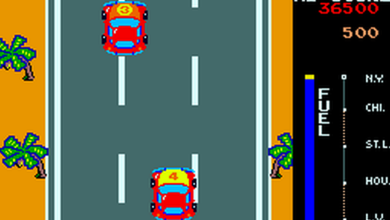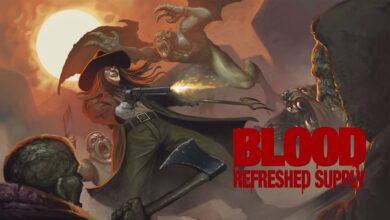Another Sunsoft classic makes a global comeback, albeit under a name you may not recognize.
There’s one more release that I feel I ought to throw in alongside this week’s assortment of reissues: Radirgy 2, the latest full-fat entry in the cel-shaded shooting game series that began in 2005 — and to be specific, I bring it up because it includes a port of the original arcade game. It’s only available in Japan, only in Japanese and has and may not be localized at any point, so if you wanna play the game on PS or Switch, you may have to bite the bullet.
Volfied
- Platform: Nintendo Switch, PlayStation 4
- Price: $7.99 / €6.99 / £6.29
- Publisher: Hamster / Taito
What’s this? A sci-fi take on Taito USA’s classic line-drawing strategic action game Qix, originally developed and distributed in arcades by Taito in 1989 and converted for various home platforms, most notably the PC Engine and Sega Genesis (as Ultimate Qix), with a later port produced for PlayStation (as Qix Neo) and emulated reissues for the likes of the Taito Memories series and the Egret II Mini. Players are tasked with drawing lines across the area of the stage in order to claim surface area, with claiming a certain percentage of each stage being the key to success; this particular take on the formula adds unique boss encounters and a much wider variety of standard enemies, a suite of uncoverable powerups and more.
Why should I care? You’ve never played a version of this particular game that wasn’t about uncovering naked ladies.
Helpful tip: Volfied can be counter-stopped without too much effort, so Hamster has helpfully added an extension to the score counter — it’s on by default in the standard modes, so you don’t need to mess with it if you’re not concerned with pure arcade authenticity.
EGG CONSOLE
Xak (PC-8801)
- Platform: Nintendo Switch (worldwide)
- Price: $6.49 / ¥880
- Publisher: D4 Enterprise / Microcabin
What’s this? The first entry in Microcabin’s five-game action-RPG series Xak, originally released for both the PC-8801 and PC-9801 and converted for MSX2 and Sharp X68000, with a Xak I&II double-pack produced for PC Engine CD by Nihon Telenet in 1992 and a Super Famicom remake produced by Sunsoft in 1993; this game liberally borrows from the bump-combat format and many other details seen in contemporary action-RPGs like Ys and Hydlide with a few wrinkles of its own, most notably the “Visual Representation” graphical style which renders the game with a slanted overhead perspective with a greater degree of implied three-dimensionality than its immediate peers.
Why should I care? For as much as Xak was a very clear attempt to jump on the bandwagon being pulled by Ys, it dodged the fate of many other similar games by being extremely well-crafted and very smooth experience, and they did throw a vertical shooting game section in towards the end, so you can’t say they didn’t offer anything original. (This game was also one of the first works by composer Ryuji Sasai, who later went on to compose cult Square fav Final Fantasy Mystic Quest, so you can expect good things from the music.)
Language barrier? Virtually every bit of text is in Japanese, and you’ll definitely hit a roadblock or two if you’re not able to read the text.
NINTENDO SWITCH ONLINE EXPANSION PASS
March ’24 update: F-ZERO Maximum Velocity (Game Boy Advance)
What’s this? The first handheld F-ZERO game, originally developed by NDcube and Nintendo and released as a launch title for the Game Boy Advance in 2001; directed and designed by original creator Kazunobu Shimizu, this game builds on the foundation of the SNES game will a much wider variety of playable vehicles with more refined, varied and granular handling, an all-new suite of pseudo-3D tracks, completely new music, graphics and characters and multiplayer for up to four players.
Why should I care? This game has been unfairly downplayed in the history of the series as a mere tech demo or rehash of the original SNES game, but compared to later games which reveled in extremely gimmicky track designs or placed an increasing emphasis on exploit-style techniques in order to keep one’s head above water, F-ZERO MV might be the most honed and least dishonest racing game in the entire series, and now it’s playable with a controller that won’t completely destroy your hands.
Helpful tip: Tap the accelerator, not the brake, to stabilize during turns!
OTHER
Felix the Cat
- Platform: PlayStation 5, PlayStation 4, Nintendo Switch (worldwide outside of Japan)
- Price: $24.99 or equivalent
- Publisher: Konami / Limited Run Games
What’s this? An emulated two-pack containing the NES and Game Boy versions of the classic Felix the Cat platformer, originally developed and published by Hudson in 1992 and never reissued before now; powered by Limited Run Games’ Carbon Engine emulator, this collection offers a save state per game, a rewind feature, basic screen options and the option to play the unreleased Famicom version (which, aside from Japanese text, is essentially identical to the NES version, as far as I’m aware).
Why should I care? Of the many NES-era Hudson/Konami games that could’ve been dragged out of the vault, this one strikes me as a particularly left-field pick — it’s not an especially well-remembered game, nor is Felix the Cat a particularly hot license, and this package will do absolutely nothing to educate or endear you to the character or its universe beyond what’s presented by the game — but if you want an example of late-era NES craftsmanship as applied to anodyne character-driven popcorn that will leave your memory the moment you stop playing, you need not look any further.
Idle speculation: The precise nature of the unreleased Japanese version included here has not been explained, nor was it even advertised as part of the package, so I can’t tell you how it was acquired, but given that the Japanese language data was present in the retail NES ROM, my hunch is that they might’ve just unearthed that data and that this isn’t a separate Famicom build per se, but I may very well be wrong.
Grandia HD Collection
- Platform: PlayStation 4, Xbox (worldwide)
- Price: $39.99 or equivalent
- Publisher: GungHo / Game Arts
What’s this? A double-pack containing the 2019 HD remasters of Game Arts’ popular 2D-on-3D turn-based fantasy RPG Grandia, originally released for the Sega Saturn in Japan in 1997 and ported to the PlayStation for global release in 1999, and its even-more-popular 3D sequel Grandia II, originally released for the Sega Dreamcast in 2000 and ported to the PlayStation 2 in 2002, with a 2015 Anniversary Edition produced for PC prior to the remaster; these versions offer a redone high-resolution UI and widescreen support, upscaled cutscenes, additional language support with dual audio and the occasional touched-up texture, plus a new hard mode for Grandia II.
Why should I care? You may recall complaints about the technical performance of both of these ports back in the day but I can tell you that they were patched to the point of recommendability, and I can only presume that they’re going to launch on PS and Xbox with that same level of technical stability. As for the games themselves, you’re looking at mostly-unadorned versions of a pair of very of-their-time JRPGs that stood out due to their unique reactive-time combat system that has never quite been replicated, and remain sufficiently compelling to drag you through the games’ weaker points.
Helpful tip: Grandia HD was purported to be based on the visually/technically-superior Saturn version of the game — it wasn’t, and that hasn’t changed, but I’d hardly say that one should be dissuaded from playing the game altogether based on that fact. What I can say is that the hideous vaseline filter applied to all of the 2D sprites was baked into the assets and is not something they can or will ever address for any version of these remasters, no matter how terrible it looks.
Hebereke Enjoy Edition
- Platform: Nintendo Switch, PC via Steam (worldwide)
- Price: $9.99 or equivalent (trilogy)
- Publisher: City Connection / Sunsoft
What’s this? An emulated reissue of Sunsoft’s multi-character exploratory sidescroller Hebereke, originally released for the Famicom in 1991 and localized for Nordic release as Ufouria: The Saga the following year, with a PlayStation port produced as part of a series of Japan-only Sunsoft reissues in 2002 and emulated reissues distributed globally via the Wii and Wii U Virtual Consoles; this City Connection-produced reissue includes save states, rewind, a speedrun mode with online leaderboards, achievements, extra controller settings, scans of the package and manual for both versions and a “Special Snap” menu that offers English translations of all of Hebereke’s Japanese text and vice-versa. (Do note that this collection allows you to play Hebereke and only Hebereke — Ufouria has not been included in this collection, and Hebereke’s in-game text remains untranslated, so you’ll need to rely on the translations in the menu to progress.)
Why should I care? Hebereke is exactly the kind of quirky, reaching-just-within-its-grasp NES game that would have become a cult favorite the world over if not for the many compromises placed upon its initial localization and subsequent reissues, so despite the fact that the publisher is delivering an untranslated Famicom game to international audiences instead of the localized version they might somewhat recognise, it’s still nice that it’s now easily available in a form that won’t make you want to hammer nails into your ears. (In case you missed it, this reissue’s tagging off the back of the just-released, out-of-nowhere sequel, so if you’re interested in either one, definitely check out the other.)
More idle speculation: The distinctive DPCM bass sound exhibited by Sunsoft’s later NES/FC releases had to be manually retimed for 50Hz PAL releases in order to sound at the correct pitch, so if one were to take the 50Hz Ufouria ROM and force into a standard NTSC emulator (as was done on the Virtual Console), the music would not only play at the wrong tempo but the bass would be thrown out of tune with the rest of the instruments, rendering the music unlistenable, so I would posit that Ufouria’s missing from this collection for the sole reason that they didn’t want to repeat that same mistake, nor could or would they go to the effort of manually converting Ufouria to 60Hz. (That said, I believe there’s an authentic NTSC NES Ufouria build out there, so c’mon…)





